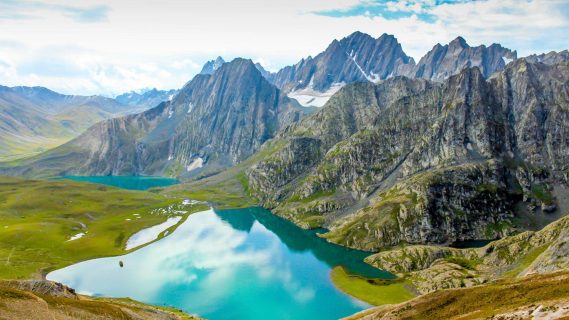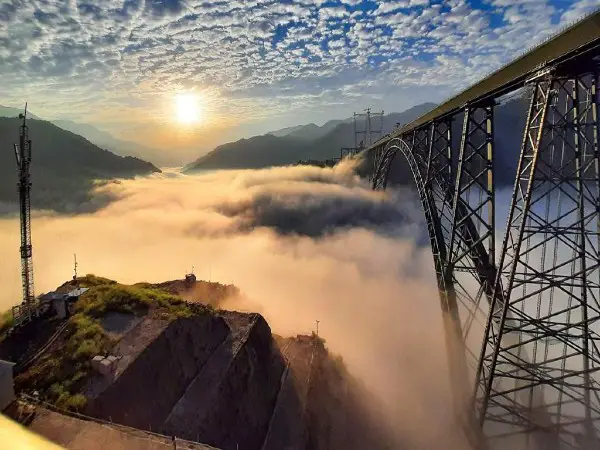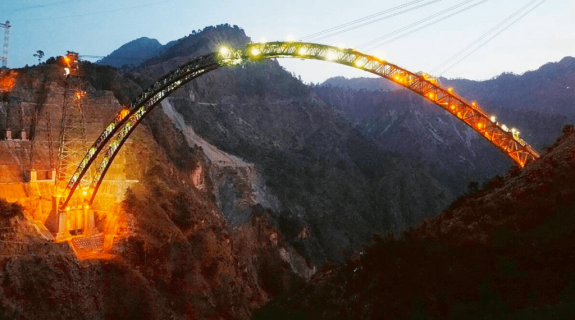The viaduct’s scaffold image is a vital intersection along the Udhampur-Srinagar-Baramulla Railway Link. The intention is to upgrade connectivity in Kashmir through its large infrastructure project. Constructing the world’s highest railway bridge of its kind required the highest level of complexity. Furthermore, challenges that immediately match its gigantic size atop the towering mountains.
Overcoming challenges: The Impressive Dimensions of the Chenab World’s Highest Railway Bridge
World’s highest railway bridge in India – the most significant engineering accomplishment. It took over 20 years for this project to come into realization. The bridge soars above 1,178 feet over the hotels of the Chenab River valley. The Chenab Bridge opened on 21 February 2024, is a key element of the USBRL project. Consequently, it is the link enabling Kashmir to be more closely in connection to the rest of the country.

The bridge will be the world’s highest. The Indian Railways, Afcons Infrastructure, and the contracted companies have to deal with it. Hence, to solve unique challenges and innovative solutions. Having the bridge opened now, India has enhanced railway accessibility and opportunities for tourism derived from such an integrated rail transportation system of a great magnitude.
Gateway to Kashmir: Enhancing Connectivity Through the World’s Highest Railway Bridge
Engineers had to come up with a sturdy and flexible steel arch framework. Hence, to make up for the bridge’s unusual height above the valley. It was resistant to hurricane-force winds and capable of absorbing vibrations. These vibrations are caused by the valley arch movement. In addition, they use them to absorb seismic shocks from earthquakes. Constructing the arch itself proved a daunting task. It required ingenious builders to invent forward cable crane. Moreover, nerve-wracking undertaking to fetch and join monstrous steel sections 1,178 feet over the rocky gorge.
Through paying close attention to the dynamics of wind that eventually shaped the final look of the bridge, the engineers were satisfied that the structure can remain stable under multiple changing load patterns. After the erection of such a long bridge ended after two decades, the unique wind resistant engineering provides for the trains to be able to cross the lofty height of the bridge as India achieves better access into Kashmir through the critical link.
The Role of the Chenab Bridge in Kashmir’s Development

Local businesses will find it easier to conduct inter-company transactions and secure external sales contracts. Indian Railways will surely have a new favorite art installation with the superlative world’s highest bridge that could in turn pave the way for better regional tourism activity due to the attraction that the bridge itself offers.
Conclusion
The superlative structure unerringly conveys India’s willingness to change in the direction of modernized infrastructure and transport networks that bind all regions together. The Chenab Bridge was just one of its many components because it had risen so high. Additionally, its ostentatious mass represented the interface between the public and the media. The bridge was the main focus of the media during the building period.
The Himalayas are great in making people fully realize the awesomeness of mounts. Alternatively, it is an icon that express the collective high and mighty aspirations of a country. Thus, people going forward together. Post the unparalleled hurdles to investigate the sky and after reaching the heavenly point, railway in the clouds, now connects the past and future and is the testimony of Kashmir’s regained glory and status of being one nation.


